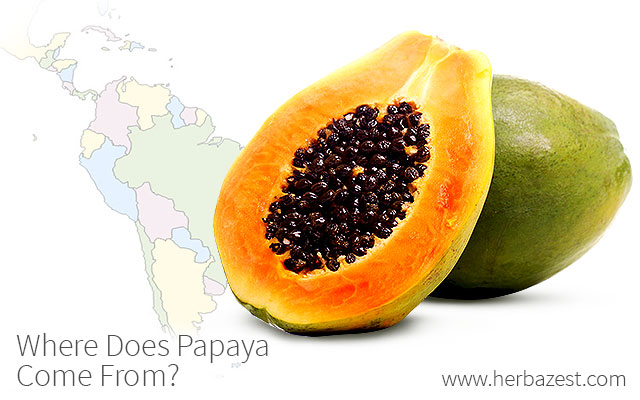The small Caricaceae family comprises about 35 species categorized into six genera. Of these species, Carica papaya is the most popular.
The papaya tree is an herbaceous plant with bright white or yellow flowers, oval, melon-like fruits, and large, deeply-lobed leaves. Of significant culinary and medicinal importance, papaya has a documented history of over 500 years of cultivation.
Origin of Papaya
Though ancient caves and gravesites sometimes provide clues for researchers, early historical evidence of papaya's history prior to European expansion has been limited. Because its fruits and seeds are easily perishable, no physical remains have been isolated which would indicate the exact point of papaya origin.
While papaya fruit origin is shrouded in mystery, it is thought to be native of tropical regions of the Americas - particularly Mexico, Central America, or the western side of South America, where several members of the family grow wild in the tropical valleys of the Andes. Early civilizations from these regions are thought to have been the first to discover the benefits of papaya, using it for both food and medicine.
In traditional folk medicine, papayas are cherished for their natural healing properties and were used for healing skin abrasions, remedying poor digestion, expelling parasitic worms, and as an anti-fertility treatment.
FOR THOSE WONDERING WHERE PAPAYAS GROW NOWADAYS, THE SIMPLE ANSWER IS ANYWHERE WITH TROPICAL WEATHER AND QUALITY PAPAYA SEED.
History of Papaya
It has been reported that papaya seeds were taken to both Panama and the Dominican Republic prior to 1525, and from there spread out over the warm regions of southern Mexico, Bermuda, the West Indies, the Bahamas, and South America. The Spanish also carried seeds to the Philippines, which quickly took over the Indian subcontinent.
Written in 1526, Gonzalo Oviedo's General and Natural History of the Indies is the first account of papaya cultivation in the New World, and reports on its importance as a crop grown on the Caribbean island of Hispaniola, as well as its cultivation by the Quebore tribe of present-day Nicaragua.
IN 1531, THE SPANISH EXPLORER FRANCISCO PIZARRO ALSO ENCOUNTERED PAPAYA PLANTS NEAR THE COAST OF ECUADOR.
In the United States, demand for papaya is significantly higher than the current supply. Prior to the 1960s, papayas were commonly grown in both southern and Central Florida, making room for a small-scale commerce. However, natural enemies and crop diseases badly threatened plant yield over time, such that growing papaya became virtually impossible.
Nowadays, after years of research and crop improvement, successful commercial production of papaya can be witnessed in parts of Hawaii, India, the Philippines, Australia, and tropical Africa, among many other places. Its culinary importance centers primarily on its fruits, but the tropical papaya plant itself holds ornamental value long after its fruits are harvested, and other parts of the plant are also significant.
The papaya leaf has been traditionally used to quiet upset stomachs. In Ghana, a decoction of papaya leaves is used as a purgative for sick horses. In the Ivory Coast, the same treatment is applied for urinary tract infections. Meanwhile, papain, an enzyme found in the milky white sap extracted from the unripe, green papaya fruit, is used to clarify beer and tenderize tough meats.
To answer the question of where does papaya come from? it is necessary to go beyond papaya's origin. While it is clear that travel and trade played a crucial role in the spread of papaya throughout tropical regions of the world, researchers lack evidence of how and where papaya split off from other members of the Caricaceae family, which makes this exotic and delicious fruit a mystery yet to be solved.
Sources
- General and Natural History of the Indies: Islands and Mainland of the Ocean, p. 323
- Missouri Botanical Garden, Carica papaya
- National Tropical Botanical Garden, Meet the Plants, Carica papaya
- Production of Papaya in Barbados, p. 1
- University of Oxford, Department of plant sciences, e-Monograph of the Caricaceae
- Useful Plants of Neotropical Origin, p. 222




